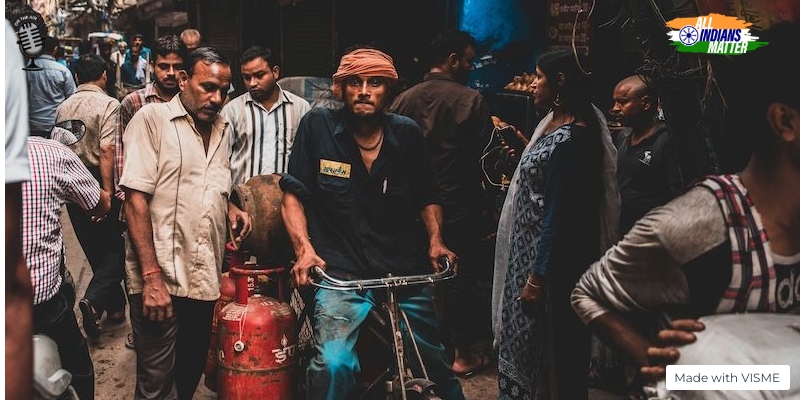Ashraf Engineer
April 27, 2024
EPISODE TRANSCRIPT
Hello and welcome to All Indians Matter. I am Ashraf Engineer.
A recent study by the World Inequality Lab said that income inequality in India is now among the highest in the world, worse than in the US, Brazil and South Africa. So gaping is the gap between the rich and the poor, the report said that income distribution was more equitable during the British Raj. The study said: “The Billionaire Raj headed by India’s modern bourgeoisie is now more unequal than the British Raj headed by the colonialist forces.”
Consider this: The top 1% of Indians earns 22.6% of the national income. The bottom 50% earns a mere 15%, according to the study. The top 1% also hold 40.1% of the wealth.
As of now, India has 271 billionaires, with 94 added in 2023 alone, according to the Hurun Research Institute’s 2024 global rich list. That’s more than in any country other than the US.
Income here refers to the sum of earnings, interest on savings, investments and other sources. Wealth is the total value of assets owned by the individual.
SIGNATURE TUNE
In 2014, Narendra Modi was elected, at least on the face of it, with a mandate for economic reforms. However, his two terms have been marked by a widening gulf between the rich and the poor. The Congress, which leads the Opposition, has repeatedly pointed to Modi’s proximity to the mega rich, especially industrialist Gautam Adani.
The widening rich-poor gap is especially stark when you consider that India has been growing in the 8% range. In fact, India could surpass Japan and Germany to become the world’s third-largest economy by 2027.
The World Inequality Lab found that the rise in inequality has been particularly pronounced since Modi and his Bharatiya Janata Party came to power in 2014. The report said that the reforms implemented have led to “an authoritarian government with centralisation of decision-making power, coupled with a growing nexus between big business and government”.
Its findings can be categorised under five key heads:
- Inequality declined after Independence till the early 1980s, after which it began rising. It soared since the early 2000s.
- Between 2014-15 and 2022-23, wealth concentration has become pronounced. By 2022-23, the top 1% income and wealth shares were at historic levels.
- There is evidence that the income-tax system is regressive when viewed through the lens of net wealth.
- There is a need to rethink the tax code to account for income and wealth. Investment in health, education and nutrition is needed to benefit the average Indian.
- The quality of economic data in India is poor and is declining. So, for all you know, the gap may be even wider than we think.
This government has glibly rejected any independent assessment of facts that show it in poor light. These range from doubts about its economic performance to the state of India’s democracy, even as it chooses to not release data that would be uncomfortable for it. In fact, India’s GDP numbers themselves have been challenged by economists. For example, former chief economic advisor Arvind Subramanian was surprised that the GDP rate is seen to be rising. India also chose to skip the census for the first time in 140 years, citing the COVID-19 pandemic. But that was years ago and there is no sign of the census yet. India has also challenged the World Health Organisation claim that COVID deaths were underestimated by a factor of 10 in the country.
Why is there such a wealth gap? You could blame it on a number of factors. For instance, globalisation and an increasingly digital world have created great opportunities for some sections while others have been left behind. What typically happens in such a situation is that the owners of capital keep getting richer. The International Labour Organisation’s data says that, in Asia-Pacific, labour has a lower income share than the world average. This means that workers have less to save and invest, further worsening inequality. The informal sector is the most vulnerable, especially women. Another factor is corruption, pro-rich tax policies and the lack of social safety nets.
In India, between 2000 and 2022, per capita income rose from $442 to $2,389. Between 2004 and 2019, the poverty rate fell from 40% to 10%. Despite this, poverty is concentrated in states that are home to 45% of India’s population but contain 62% of its poor. There are many who live just above the poverty line. These people are at risk of falling back into poverty.
Several factors, such as the lack of education, have trapped many in low-paid jobs and depressed the growth of the bottom 50% and middle 40% of Indians.
The inequality calls for a change in tax policies for wealth redistribution. According to the World Inequality Lab study, the income-tax system is needs an overhaul. The report said: “A restructuring of the tax code to account for both income and wealth, and broad-based public investments in health, education, and nutrition are needed to enable the average Indian, and not just the elites, to meaningfully benefit from the ongoing wave of globalisation.” A “super tax” of 2% on the net wealth of the 167 wealthiest families in 2022-23 would yield 0.5% of national income in revenue and provide a fund for social investments.
The average Indian won’t gain from a modernising and globalising economy unless there is an effective redistribution of wealth and the investments I detailed above are made. Without it, the slide towards an oligarchy will pick up speed.
India was once the template for newly-free countries who based their policies and institutions on ours. Not anymore.
Thank you all for listening. Please visit allindiansmatter.in for more columns and audio podcasts. You can follow me on Twitter at @AshrafEngineer and @AllIndiansCount. Search for the All Indians Matter page on Facebook. On Instagram, the handle is @AllIndiansMatter. Email me at editor@allindiansmatter.in. Catch you again soon.






